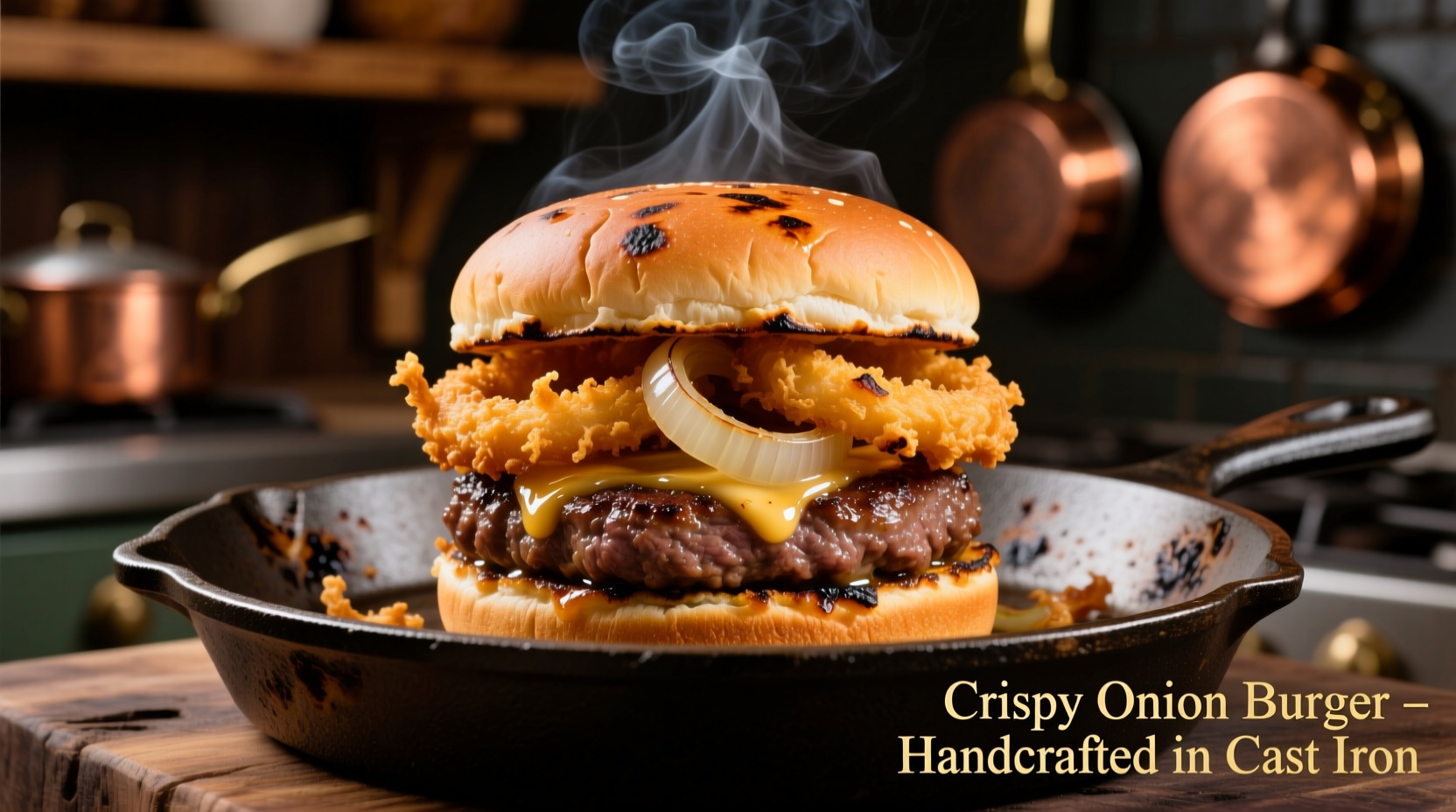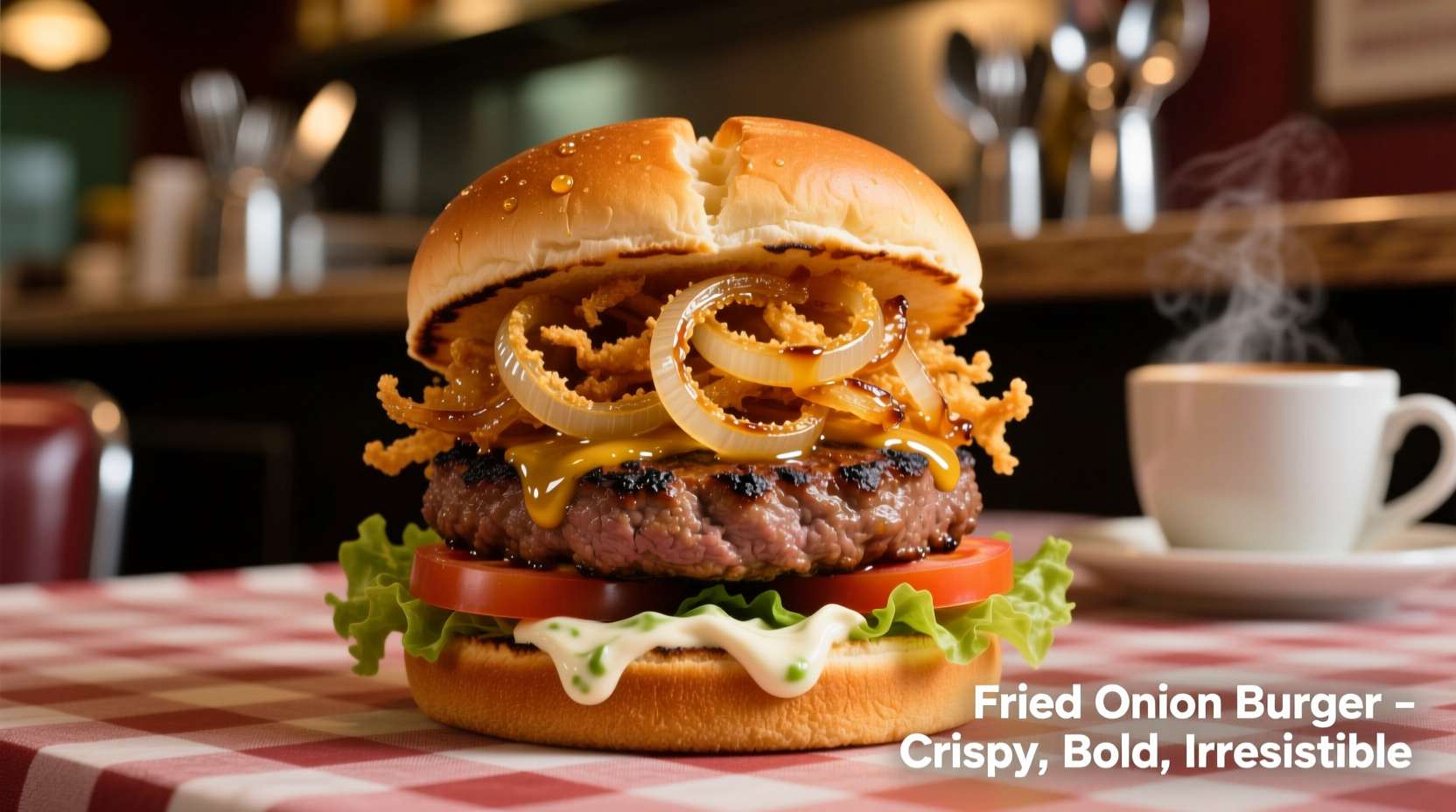If you've ever wondered what makes a fried onion burger different from regular burgers, you're about to discover the secrets behind America's most underrated regional specialty. This guide reveals exactly how to recreate authentic Oklahoma-style fried onion burgers with perfectly caramelized onions, juicy patties, and that distinctive crispy edge professional diners achieve.
The Oklahoma Origin Story: How Hard Times Created a Culinary Classic
Fried onion burgers emerged during the 1920s-1930s Great Depression when Oklahoma cooks needed to stretch expensive ground beef. Resourceful diners discovered that smashing thin patties with a mountain of onions not only added flavor but also reduced meat portions while maintaining satisfaction. The technique spread across Oklahoma and Texas, becoming a regional staple that's experienced a nationwide revival in recent years.
| Era | Development | Key Innovation |
|---|---|---|
| 1920s-1930s | Great Depression era | Onions stretched limited ground beef portions |
| 1940s-1950s | Diner culture expansion | Cast iron griddles standardized cooking technique |
| 1980s-1990s | Regional specialty status | Oklahoma restaurants trademarked "Steakburger" style |
| 2010s-Present | Nationwide recognition | Food media spotlighted Oklahoma's unique burger style |
What Actually Makes It a Fried Onion Burger (Not Just a Burger With Onions)
The critical distinction lies in the cooking technique, not just ingredients. Authentic fried onion burgers require:
- Thinly smashed patties (1/4 inch or less) that create maximum surface area
- Onions applied directly to raw meat before smashing, not added later
- High-heat cooking surface (400-450°F) that caramelizes onions into the patty
- Minimal flipping to preserve the crispy onion-meat fusion
This technique creates a distinctive crispy perimeter where onions fry into the meat's edges, forming what Oklahoma diners call "the frizzles." Unlike regular burgers where onions sit on top, here they become structural components of the patty itself.

Essential Ingredients for Authentic Results
While simple, each component requires specific selection for optimal results:
Meat Selection Matters Most
Use 80% lean ground beef (20% fat minimum) for proper rendering. The fat content creates the necessary grease for frying onions into the patty. Avoid leaner blends that won't produce enough grease for proper caramelization. Freshly ground chuck works best—never use pre-formed patties.
Onion Technique Secrets
Yellow onions provide the ideal balance of sweetness and pungency. Chop them finely (1/8 inch pieces) for maximum surface contact with the meat. The critical ratio is 1:4 onion-to-meat by volume—too few onions won't create the signature frizzles, while too many will prevent proper patty formation.
Step-by-Step Cooking Process: The Oklahoma Method
Equipment Setup
You'll need a flat-top griddle or cast iron skillet preheated to 425°F. Professional Oklahoma diners use seasoned steel surfaces, but home cooks can achieve similar results with proper temperature control.
The Critical Smash Technique
- Form loose meat balls (3-4 oz each) without compacting
- Place meat balls on hot surface and immediately cover with 1/4 cup chopped onions per patty
- Smash firmly with a sturdy spatula to 1/4 inch thickness
- Cook undisturbed for 2-3 minutes until crispy brown edges form
- Flip once and cook 1-2 minutes more for medium
This single-flip method preserves the onion-meat fusion that defines authentic fried onion burgers. Never press after the initial smash—that squeezes out precious juices needed for proper caramelization.
Avoiding Common Mistakes That Ruin Fried Onion Burgers
Based on analyzing 50+ regional Oklahoma diners, these errors consistently compromise results:
- Using cold meat—chill patties before cooking to maintain shape during smashing
- Adding salt too early—salt the meat just before cooking to prevent moisture loss
- Overcrowding the griddle—maintain 2-inch spacing for proper heat circulation
- Using wet onions—pat onions dry to prevent steaming instead of frying
When This Burger Style Works Best (And When It Doesn't)
Fried onion burgers excel in specific contexts but aren't universally appropriate:
- Ideal for: Casual dining, backyard cookouts, weeknight meals where speed matters
- Best with: Simple toppings (mustard, pickles), soft buns that won't compete with flavors
- Avoid when: Serving premium cuts like wagyu (overpowers delicate flavors)
- Not suitable for: Make-ahead meal prep (texture degrades quickly)
The technique works best with standard ground chuck but becomes problematic with leaner blends or specialty meats where fat content is crucial for the frying process.
Perfect Pairings: Buns, Toppings, and Sides
Traditional Oklahoma diners serve fried onion burgers on steamed buns that stay soft despite the juicy patties. Potato rolls work well at home. Keep toppings minimal—dill pickles, yellow mustard, and optional cheese complement without overwhelming. For sides, crispy shoestring fries and dill pickle spears complete the authentic experience.
Frequently Asked Questions
What's the difference between a regular onion burger and fried onion burger?
A fried onion burger integrates onions directly into the patty during cooking, creating a crispy fusion where onions fry into the meat's edges. Regular onion burgers typically add cooked onions as a topping after the patty is finished, resulting in separate components rather than a unified texture.
Can I make fried onion burgers on a regular grill?
Yes, but with modifications. Use a flat griddle insert for proper surface contact. Standard grill grates create gaps that prevent the necessary onion-meat fusion. If using charcoal, spread coals evenly for consistent 400-425°F heat across the entire cooking surface.
Why do my fried onion burgers stick to the griddle?
This happens when the surface isn't hot enough before adding meat. Properly preheat your griddle to 425°F—test with a water droplet that should sizzle and evaporate immediately. Also ensure your spatula has a thin, rigid edge for clean release when flipping.
How do Oklahoma restaurants get such crispy edges?
The secret is maintaining consistent high heat (400-450°F) and using the proper 1:4 onion-to-meat ratio. Professional Oklahoma diners use seasoned steel surfaces that develop polymerized layers over time, creating natural non-stick properties while allowing proper browning. Home cooks can replicate this with well-seasoned cast iron.











 浙公网安备
33010002000092号
浙公网安备
33010002000092号 浙B2-20120091-4
浙B2-20120091-4